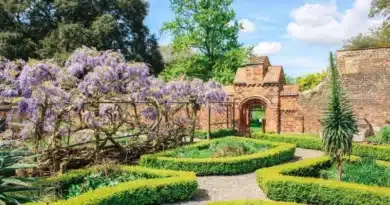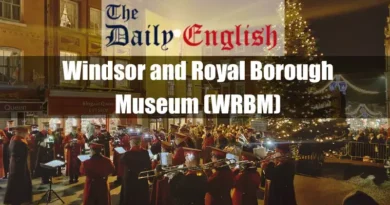I. Introduction: A Jewel in the Crown of Windsor Castle
Windsor Castle, a sprawling residence perched on a hill overlooking the River Thames, has been a royal home for over 900 years. A treasure trove of history, art, and architectural splendour lies within its majestic walls. But one particular room stands out for its sheer opulence and grandeur – the Grand Reception Room.
Imagine yourself transported to a bygone era of glittering balls and elaborate social gatherings. Picture a space adorned with swirling Rococo plasterwork, shimmering chandeliers, and walls with priceless tapestries. This is the Grand Reception Room, a testament to the artistry and grandeur that defined British monarchy. Over the centuries, it has witnessed countless historical events, from lavish celebrations to critical state meetings. Delving into its rich tapestry, we’ll explore its fascinating history, architectural details, and enduring legacy as a symbol of royal power and artistic achievement.
II. History of the Grand Reception Room
A. Origins and Early Use
The Grand Reception Room’s story begins not with a ballroom waltz but with the clang of a blacksmith’s hammer. Originally built in the mid-14th century under King Edward III, the room served a far more practical purpose. Back then, it was known as the Great Chamber, a large, multi-functional space within the Upper Ward of the castle. Imagine bustling courtiers, not waltzing couples, filling the room. Here, Edward III likely held court, received petitions, and hosted important war councils.
The Great Chamber’s early design details are unknown from this period. However, historical records suggest a large, rectangular space with high ceilings, likely featuring exposed wooden beams and simple stone walls. It wouldn’t have been a lavish space by modern standards. Still, it was a significant room for its time, reflecting the power and status of the English monarchy.
B. Transformation under George IV
King George IV ascended the throne in 1820 and, unlike his more austere father, George III, craved a life of luxury and theatricality. He found Windsor Castle’s medieval interiors somewhat outdated for his tastes and desired a more dazzling showcase of the British monarchy’s grandeur. Enter Sir Jeffry Wyatville, a renowned architect tasked with transforming the castle.
Wyatville envisioned a radical transformation for the Great Chamber. The early 19th century saw the Rococo style’s peak popularity, characterized by its playful curves, intricate plasterwork, and lavish ornamentation. Wyatville embraced this exuberant aesthetic, discarding the Great Chamber’s unknown details in favour of the new design. Soaring ceilings were adorned with elaborate plasterwork featuring swirling acanthus leaves, shells, and floral motifs. Exposed beams, if present originally, were replaced by a richly decorated cove cornice, adding a touch of drama. Once bare stone walls were now swathed in shimmering silk damask, often adorned with portraits of royalty.
This transformation went beyond aesthetics. Wyatville completely reimagined the room’s functionality. Large windows were installed on one side, flooding the space with natural light and creating a more inviting atmosphere. Fireplaces were redesigned with ornate marble surrounds, adding warmth and grandeur. The most significant change, however, was the lowering of the floor level. This created a more impressive sense of volume, perfect for hosting lavish balls and social gatherings. The transformation was complete – the Great Chamber was reborn as the Grand Reception Room, a dazzling testament to the luxury and extravagance of the Regency era.
Also, read:
- The Old Court Arts Centre, Windsor’s History & Today
- Windsor and Royal Borough Museum (WRBM)
- Adelaide Cottage, Windsor
C. The Grand Reception Room in Use
With its dramatic makeover complete, the Grand Reception Room became the beating heart of Windsor Castle’s social scene. Imagine the scene: shimmering chandeliers glowed on polished floors as elegantly dressed ladies and gentlemen twirled in a waltz. The air buzzed with conversation, laughter, and the rhythmic strains of a Royal Philharmonic Society orchestra. The Grand Reception Room wasn’t just a ballroom; it was a stage for showcasing the wealth and power of the British monarchy.
Throughout the 19th and early 20th centuries, the room hosted various events. State visits from foreign dignitaries were often marked by lavish balls held in the Grand Reception Room. Queen Victoria, known for her fondness for hosting grand events, used the space for court presentations and celebrations like the Garter Investiture ceremony. Royal weddings, christenings, and even birthday celebrations for extended royal family members were held within these opulent walls.
The Grand Reception Room wasn’t just about frivolity; it also served a more serious purpose. On occasion, it was used for important meetings and ceremonies. For instance, following Queen Victoria’s death in 1901, the Accession Council, where her son Edward VII formally assumed the throne, was held in the Grand Reception Room. This juxtaposition of grand balls and solemn ceremonies highlights the room’s versatility and its enduring role as a witness to significant moments in British royal history.
One particularly interesting event held in the Grand Reception Room was the investiture ceremony for Winston Churchill as a Knight of the Garter in 1946. This prestigious ceremony, dating back to the 14th century, is the highest order of chivalry in Britain. The Grand Reception Room, with its opulent setting, provided a fitting backdrop for this recognition of Churchill’s immense contributions as Prime Minister during World War II.
Also, read:
- Eton College Windsor: A Legacy of Excellence
- Frogmore House Windsor: A Royal Retreat Through Centuries
- Adelaide Cottage Interiors: Unveiling the Mysteries
III. Architectural Details

The Grand Reception Room’s grandeur isn’t simply a product of its opulent furnishings and decorations; it’s fundamentally rooted in its impressive architecture. Let’s delve into the key elements contributing to this magnificent space’s awe-inspiring presence.
A. A Breathtaking Canvas: Dimensions and Layout
Imagine yourself standing at the entrance of the Grand Reception Room. The sheer scale of the space would likely take your breath away. Stretching an impressive length and reaching a significant width, the room boasts a truly palatial feel. High ceilings add to the sense of grandeur. Large windows line one side of the room, bathing the space in natural light and offering a glimpse of the manicured castle grounds. This combination of generous dimensions and ample natural light creates an impressive and inviting atmosphere.
B. Gateway to Grandeur: Architectural Elements
Step further into the room, and your eyes will be drawn to the architectural elements that elevate its design. The grand doorways, adorned with ornate architraves and carvings, serve as a fitting introduction to the abundant space beyond. Look upwards, and your gaze will meet the richly decorated cove cornice that frames the ceiling, adding a layer of visual interest and grandeur. Take note of the intricately moulded skirting boards that grace the base of the walls, further emphasizing the room’s elegance and attention to detail. While seemingly simple, these architectural elements create a visually stunning, cohesive space.
Also, read:
- Windsor Castle Opening Times: Everything You Need to Know.
- Windsor Castle Tickets: A Proven Comprehensive Guide.
- Windsor Castle Changing of the Guard: Where History Coming Alive.
- Windsor Castle Tour: A Comprehensive and Best Guide.
- Windsor Castle Tickets Advantage Card: Know Everything.
IV. Furnishings and Decor

The Grand Reception Room wouldn’t be the opulent spectacle it is without its exquisite furnishings and decorative elements. Imagine yourself transported back to a glittering ball. Crystal chandeliers cast a warm glow on the polished wood floor as guests mingle amidst a carefully curated collection of furniture and art. Let’s explore the key components that bring this grand space to life.
A. A Ballroom Adorned: The Art of Furniture
The Grand Reception Room’s primary function as a ballroom is reflected in its furniture selection. Ornate seating arrangements line the walls, providing comfortable spots for guests during social gatherings. Elegant side tables, often featuring beautiful craftsmanship, add a touch of sophistication and offer convenient surfaces for refreshments or decorative objects. Scattered throughout the room, you might find intricately designed chairs and armchairs, upholstered in luxurious fabrics, offering additional seating options.
Central Stage for Grandeur:
Undeniably, the central space reserved for dancing takes centre stage. The absence of permanent furniture allows for the free flow of movement, which is essential for a grand waltz or a lively quadrille. Imagine the scene: elegantly dressed ladies twirling in their flowing gowns, their partners guiding them across the polished floor under the watchful gaze of portraits adorning the walls. The very arrangement of the furniture reinforces the Grand Reception Room’s primary function as a space for social gatherings and grand celebrations.
B. Artistic Flourishes: Beyond the Ballroom Essentials
The Grand Reception Room’s grandeur extends beyond the necessities of a ballroom. The walls, adorned with shimmering silk damask wallpaper, are further enriched by meticulously woven tapestries. These tapestries depict various subjects, potentially including historical scenes, mythological figures, or landscapes. Imagine the rich colours and intricate details of these tapestries, each adding a layer of cultural and artistic significance to the space.
Dotted around the room, you might also find sculptures crafted from marble or bronze. These sculptures depict a range of subjects, possibly including historical figures or classical deities. They add visual interest and serve as a reminder of the British monarchy’s rich cultural heritage and appreciation for the arts. Nestled in a corner, you may even discover a grand piano, its polished surface reflecting the shimmering chandeliers and adding a touch of musicality to the room. These artistic flourishes, meticulously chosen, elevate the Grand Reception Room from a mere ballroom to a space imbued with cultural and historical significance.
Also, read:
- How to Get to the Windsor Castle from London
- Who Lives in the Windsor Castle?
- Are Babies Free for Windsor Castle
- Are Dogs Allowed into Windsor Castle
- Comparing Shops Near Windsor Castle
V. The Grand Reception Room Today

The Grand Reception Room’s story doesn’t end with the fading echoes of a long-ago waltz. This magnificent space has faced its share of challenges. Still, its enduring legacy as a symbol of royal history and artistic achievement remains firmly intact.
A. A Devastating Blow: The Fire of 1992
In 1992, a devastating fire ripped through Windsor Castle, causing significant damage to the State Apartments, including the Grand Reception Room. The fire, caused by a faulty spotlight, ravaged the room’s opulent furnishings and decorations. The ornate plasterwork suffered extensive damage, and the priceless silk damask wallpaper was left in tatters. The sight of this once-magnificent space reduced to a shell must have been a heartbreaking blow to the Royal Family and the nation.
Related articles:
- Devastating Timeline of the Windsor Castle Fire 1992.
- The Windsor Castle Fire Salvage Operation 1992.
- The Extent of Damage to Windsor Castle Due to the 1992 Fire.
B. A Room Reborn: The Meticulous Restoration
However, the spirit of the Grand Reception Room wouldn’t be extinguished. A meticulous restoration project was launched, estimated to have cost over £50 million. Craftsmen and artisans from across the country painstakingly recreated the room’s intricate plasterwork, using traditional techniques to ensure historical accuracy. New silk damask wallpaper, based on surviving fragments, was woven to replace the fire-damaged sections. Lost or damaged furniture was meticulously restored or replaced with pieces from the Royal Collection, ensuring historical continuity.
The restoration process wasn’t just about aesthetics; it was about preserving a vital piece of British history. The Grand Reception Room is a tangible link to the past, a witness to centuries of royal history. Its restoration ensured that future generations could still experience its grandeur and appreciate the artistry that defines it.
C. A Legacy Enduring: A Symbol of History and Splendour
Today, the Grand Reception Room stands proudly restored, a testament to the enduring legacy of British craftsmanship and the commitment to preserving royal history. It continues to be used for state visits, investiture ceremonies, and even select public tours. Stepping into this magnificent space is like stepping back in time, a chance to experience a bygone era of opulent balls and royal grandeur.
The Grand Reception Room serves as a multifaceted symbol. It’s a showcase of artistic achievement, a testament to the enduring power of British royalty, and a reminder of the importance of preserving our historical heritage. As long as Windsor Castle stands, this magnificent space will continue to captivate visitors and act as a vibrant and enduring symbol of a bygone era.
Also, read:
- The Mystery of 2 Windsor Castles
- Are There Guided Tours of Windsor Castle
- Are There Mice in Windsor Castle
VI. Conclusion: A Waltz Through Time

Exploring the Grand Reception Room has taken us on a fascinating journey through history, artistry, and royal intrigue. We’ve witnessed its transformation from a practical medieval chamber to the dazzling ballroom that defines it today. The intricate plasterwork, shimmering chandeliers, and opulent furnishings all contribute to a space that’s awe-inspiring and evocative of a bygone era.
The Grand Reception Room isn’t just a beautiful room; it’s a living testament to the enduring legacy of British history. It has witnessed centuries of celebrations, ceremonies, and even moments of national significance. The meticulous restoration following the devastating fire of 1992 underscores the importance of preserving this vital piece of the nation’s cultural heritage.
As we conclude our exploration, a final thought lingers. Imagine the room in its heyday, the polished floor reflecting the shimmering light, the air buzzing with conversation and laughter. Picture the waltzing couples, their elegant attire swirling in a timeless dance. The Grand Reception Room isn’t just a space; it’s a stage upon which history unfolds, a waltz through time that continues to captivate us today.
The story of the Grand Reception Room is far from over. It will continue to serve as a backdrop for future events, a silent witness to the ever-evolving history of the British monarchy. And for visitors lucky enough to experience its grandeur, it will remain a captivating portal to a bygone era. In this place, the echoes of history still resonate.
Also, read:
- Are There Stables at Windsor Castle
- Are There Steps, Elevators or Lifts in Windsor Castle
- Are There Women in the Coldstream Guards at Windsor Castle
VII. Frequently Asked Questions (FAQs) about the Grand Reception Room
1. Who were some notable figures who have visited or participated in events at the Grand Reception Room?
The Grand Reception Room has witnessed many historical figures over the centuries. Queen Victoria, known for her fondness for grand events, hosted numerous state visits from foreign dignitaries within its walls. The room continues today’s tradition as a backdrop for important occasions. Additionally, the Grand Reception Room has been the stage for the investiture ceremonies of prominent individuals. For instance, Winston Churchill, the famed wartime Prime Minister, received his Order of the Garter in 1946.
2. What are some of the artistic styles or movements reflected in the Grand Reception Room’s design beyond Rococo?
While the Rococo flourishes dominate the Grand Reception Room’s design, the room’s overall layout and grand proportions reflect the Georgian architectural style that dominated British construction in the early 18th century. Its integration within the State Apartments suggests a cohesive aesthetic approach, emphasizing a sense of timeless elegance through its balanced proportions and formal layout.
3. Does the Grand Reception Room house any permanent art pieces, such as paintings or sculptures?
The Grand Reception Room’s artistic flair extends beyond the Rococo plasterwork. The walls are often adorned with tapestries depicting historical scenes, mythological figures, or landscapes. These tapestries, likely commissioned from renowned weavers in the past, add historical and cultural significance. Sculptures crafted from marble or bronze depicting historical figures or classical deities may also be found throughout the room.
4. How does the Grand Reception Room compare to other grand ballrooms in British royal residences, such as Buckingham Palace?
While the Grand Reception Room and the Ballroom at Buckingham Palace serve as grand settings for royal events, they offer distinct experiences. With its Rococo flourishes and more intimate scale, the Grand Reception Room evokes a sense of opulence reminiscent of an earlier era. In contrast, the Buckingham Palace Ballroom, built in the 19th century, features a neoclassical grandeur with soaring ceilings and a likely larger footprint, reflecting the evolution of architectural styles.
5. Is there any information about the architects or artisans contributing to the room’s original design or restoration?
Sir Jeffry Wyatville, the architect, spearheaded the room’s transformation into the Rococo masterpiece we know today. He undoubtedly collaborated with a team of skilled artisans to achieve this grand design. Unfortunately, individual records of these craftspeople from the early 19th century might be difficult to locate. However, the meticulous restoration project following the fire in 1992 involved a new generation of artisans. Using traditional techniques, these skilled craftspeople ensured the room’s historical accuracy and preserved its beauty for future generations.
6. What specific challenges did the restoration project face beyond the fire damage?
The restoration of the Grand Reception Room went beyond simply repairing fire damage. Sourcing materials that matched the originals proved to be a significant challenge. Replicating the intricate plasterwork, for instance, required locating specialist plasterers with the necessary skills and knowledge of historical techniques.
7. Does the public have any opportunities to see the Grand Reception Room, or is it reserved for private events?
While the Grand Reception Room remains primarily a space for state visits and royal events, the public does have limited opportunities to experience its grandeur. The Royal Collection occasionally offers select guided tours of the State Apartments, which may include a glimpse of the Grand Reception Room. Availability for these tours can be limited, so checking the official website of the Royal Collection Trust for current offerings and booking procedures is recommended. The Royal Collection website also offers virtual tours and online resources that provide a digital window into this magnificent space.










Comments are closed.